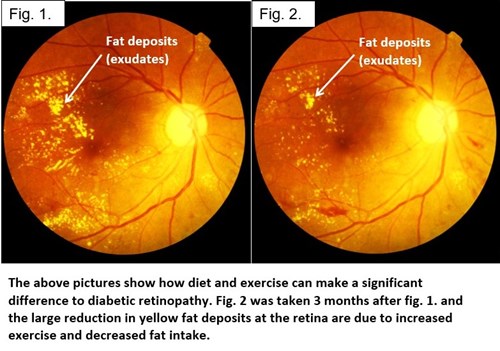The effect of HbA1c, blood pressure and cholesterol on diabetes-related retinopathy
It is well recognised that controlling systemic factors and changing one’s lifestyle can significantly delay the progression of diabetes-related retinopathy and in some cases reverse it.
Therefore eye doctors monitoring patients with diabetes-related retinopathy will often ask about HbA1c, blood pressure, cholesterol, diet and exercise.
HbA1c
This is a blood test organised by the doctor responsible for looking after your diabetes that looks at the link between red blood cells and sugar (glycosylated haemoglobin). The result is a number that indicates how high your blood sugar has been on average, over about 3 months. It is the single most important test in knowing how well your diabetes is controlled.
An individual target is usually set with your doctor, but generally speaking, the target is approximately 53 mmol/mol. Consistently high levels of HbA1c mean a greater risk of development and progression of diabetes-related retinopathy, and thus sight loss. Improving diabetes control by decreasing your HbA1c reduces your chance of developing diabetes-related retinopathy and you can reverse diabetes eye changes that already exist.
Blood Pressure
Blood is carried around the body in pipes called blood vessels. The pressure in these blood vessels is measured with a cuff on the arm and is called blood pressure. There are two numbers, the bigger one is the maximum pressure and the smaller one is the minimum pressure in the blood vessels. Generally speaking the smaller both these numbers are the better they are for your overall health, including your eyes.
People with diabetes who visit the eye clinic should aim to have blood pressure of 130/80 mmHg or lower.
High blood pressure can cause both leakage and blockage of blood vessels in the retina. So by reducing your blood pressure you can reverse diabetes eye changes and even prevent them happening.
Healthy eating, regular exercise and blood pressure tablets all help to reduce blood pressure.
Cholesterol
Cholesterol is the amount of fats that are found in blood. People with diabetes often have raised cholesterol and this leads to blocked blood vessels or leakage of fat into the retina. When there are fat deposits at the macula this contributes to diabetes maculopathy.
By reducing your cholesterol, you can improve diabetes eye changes and minimise the chance of them happening.
People with diabetes should aim to have a total cholesterol of 4 mmol/l or less. A healthy diet and regular exercise can help improve cholesterol levels but many people also require cholesterol tablets known as statins to reduce cholesterol to the target level.

Improving diabetes control can lower HbA1c, which reduces your chance of developing diabetic retinopathy – and may even reverse it




